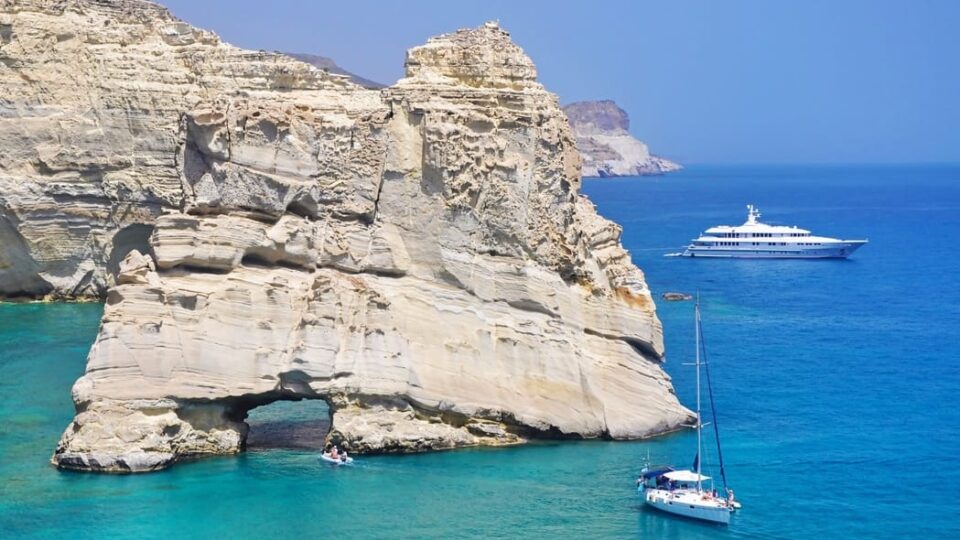Sailing in Greece: Greek Island Sailing Guide
Greece is one of the most popular European sailing areas. The country features over 3,000 islands; a sailors’ paradise in the Mediterranean. It boasts a diverse range of climate zones and vegetation, as well as significant cultural and historical destinations and sites. Because Greek sailing locations have so much to offer, from countless islands to cultural history and many options to choose from, you will need more than one sailing voyage to fully appreciate this magnificent country, whether you are a beginner or an experienced sailor. So, in this Greek Island Sailing Guide I will help you by listing the country’s most beautiful islands that are suitable for a sailing voyage. So, keep reading!
Best Time to Sail in Greece
The Ionian Sea, the Cyclades, the Saronic Gulf, the Dodecanese, and the Sporades are the most popular sailing destinations in Greece. The Ionian Sea and the Saronic Gulf are ideal for beginners. But, the Cyclades are best for experienced sailors in the spring or autumn, as high winds of up to 8 Beaufort can occur during the summer months.
The sailing season in Greece is similar to that of other Mediterranean countries, lasting from April until November. From the last week of June through the middle of September, the peak/high season is in full swing. Expect busy marinas and ports, as well as a large number of day-tripper motorboats. These may use the bulk of port moorings on islands, so be prepared to anchor on occasion. There are numerous sailing yachts, catamarans, motorboats, and gulets available for charter at reasonable prices. This applies just in case you’re not sailing with your own boat.
Keep in mind that the summer months can be extremely hot and dry, with plenty of sun and temperatures reaching 35°C along the coast and on the islands. However, in the Cyclades, the Meltemi winds can blow for weeks and reach up to 8 Beaufort in July and August. The greatest time to sail is during the shoulder seasons, which begin from late June until late September. Due to Greece’s vastness, there are geographical changes in season; for example, summer and shoulder seasons are longer in the south of the Aegean islands, and you can still swim in December.
So, after this brief information let’s move on and explore the ideal sailing locations in the Greek Islands!
The Cyclades Islands
The Cyclades are the classic Aegean island group. The islands are the most popular sailing area in the Aegean nowadays, thanks to the numerous destinations. The islands have an austere beauty due to their aridity and stony terrain. Their traditional architecture, which includes white and blue houses and arches, blends quite well with the surrounding landscape. From the volcanic Santorini to the secluded Schinoussa, each island has its own personality and individuality. There are several attractive viewing places as well as various anchorages for cruisers. From the trendy Mykonos and cosmopolitan Syros to the inhabited Greater Delos, there’s something for everyone.
It is possible to start your voyage from the Vourkari marina on the island of Kea, which is practical and accessible to the marinas surrounding Athens. This is because Kea is the Cycladic island closest to Athens. Of course, you can begin your cruise on any other island. You can also choose to skip or add islands to your overall cruise. You begin by sailing in a southerly direction, then east, and ultimately northwest to complete the circle. Although the distances are minimal, it is recommended that you allow at least a month for the journey due to the numerous islands. If you’re short on time, it’s preferable to visit fewer islands. Like this, you will spend a couple of days on fewer islands but make the most out of them. Also, you can choose to rent a motor-scooter or a car in order to explore the land.
Let’s see some must visit islands in the Cyclades complex!
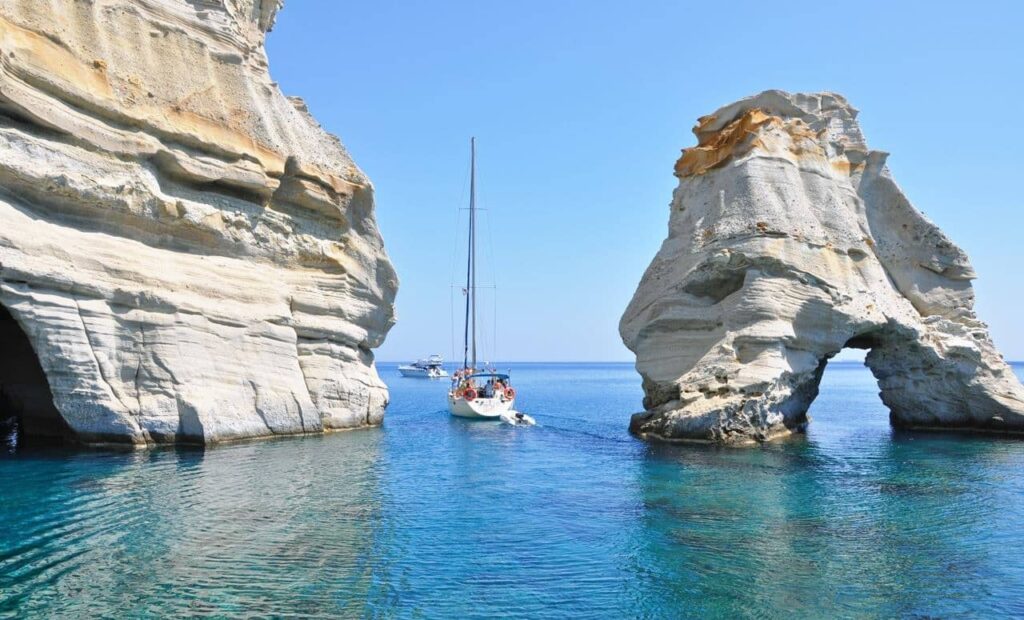
>>Also Read: Best Sailing Destinations in Greece
Santorini – Anafi
The best way to approach Santorini by boat is to enter the caldera from the northwest. The island’s exceptional natural structure and archaeological ruins, which are among the most important in Greece and the Mediterranean, have attracted a considerable number of visitors in recent decades. Santorini is the most active part of the South Aegean Volcanic Arc. It stretches 500 kilometers from Turkey to Greece’s mainland and is 20 to 40 kilometers broad.
The Marina of Vlychada is located on Santorini’s southern edge. It’s regarded as the only harbor where you may safely moor your boat during a Meltemi or leave it in order to explore the island. Ammoudi, which has a short mole, is located on the northwest tip of Thira, beneath the historic hamlet of Oia. But, there is a groundswell and it is exposed to most winds. However, Oia is a must-see and is best visited by scooters via Vlichada. In lighter weather, there are several anchorages south of the Akrotiri peninsula and cape. For example, the Black Beach and further east the Red Beach. Fira, Perissa, and Imerovigli are also some must-see villages. There you can have your lunch, drink, and stroll around the white and blue alleys.
Anafi is located near Santorini on the southeastern point of the Cyclades island complex. The island’s golden beaches and emerald waterways will offer you a relaxing vacation in nature. Chora is the main inhabited area and has a breathtaking view of the Cretan Sea. Anafi is constructed in the traditional Cycladic style, but with its own unique characteristics. The island has a rather high altitude for its size. Kalamos is one of the largest rocks in the Mediterranean. It stands at 460 meters high and giving the island an almost conical shape. The location of the ancient city is north-east of Chora, on the round-topped hill of Kastelli, with remains of walls and sculptural fragments. Lastly, during the summer breezes, Megas Potamos Bay offers fantastic anchoring.
Milos – Kimolos
Milos is the southwesternmost island in the Cyclades group. In the past, the island’s volcanic activity has created an interesting array of stunning landscapes. The unusual formations of the rocks and their spectacular tints on the gorgeous white sandy beaches are one hint of Milos’ volcanic qualities; another is the economic activity from the minerals such as obsidian, sulfur, kaolin, and others. As a result, Milos is home to one of the Mediterranean’s oldest mines. The best way to discover Milos is by boat.
The island has over 75 large and small, rocky and sandy, colorful and white beaches washed by clear crystal blue and turquoise sea. Milos’ beautiful coastlines, as well as the nearby islands of Kimolos and Polyegos, are ideal for a cruise. The greatest anchorages are Dimitrios Cove, Megali Ammos, and Fatourena. Also on the south coast, the bays of Tsigrado and Fyriplaka feature a beautiful seascape and decent protection from the northerlies.
Kimolos, the Cyclades’ hilliest island, is the one closest to Milos and has a predominant color as white as the chalk it produces. In antiquity, Kimolos was noted for its chalk, which was used as a detergent and also in medicinal baths. It’s a lovely, little, untouched, peaceful island. Despite its vicinity, it does not attract a large number of travelers. As a result, if you’re seeking peace and quiet in a beautiful setting, this is the place to go. Aliki, Ellinika, Kambana, Klima, and Prassa are excellent beaches with primarily white strands of coarse sand and with several shaded isolated coves nearby. Moreover, there are several tiny bays on the island. But, the three main bays are the two near Psathi on the island’s south side and the Prasonisi bay on the island’s east side.
Naxos and Small Cyclades
The island of Naxos, the largest and most picturesque of the Cyclades, is spanned from north to south by a range of hills. These fall away steeply to the east but gradually slope down to lush farmland and well-watered plains on the west. Two passes cut across the hills, which peak to a height of 1008 meters. It is the Cyclades’ largest and greenest island; it offers both tranquility and crowded places like the Chora of Naxos. Visit the small fishing village of Apollonas and anchor in Azala bay; a pebbled beach with sandy holding ground. Also, visit the Acropolis ruins in Panormos village and dock in Agia Anna bay where you can hike to the Ionic Temple.
The Small Cyclades consist of Donousa, Koufonissia, Antikeros, Drima, Schinoussa, and Irakleia. Small gems around Naxos that provide magnificent bays, tranquility, hiking, as well as small local tavernas and bars. Enjoying fresh seafood with ouzo and mezedes near the shore in a small local taverna is a must when sailing to the Small Cyclades. Admire the aquatic life that has flooded the plane’s steel remnants in the Aegean Sea crystal clear waters. Sail to the little islands of Schinoussa or Koufonisia to discover for yourself why they are referred to as “a piece of heaven.”
As you go from one island to another, you will anchor to different locations. Like this, you will swim on many isolated beaches and coves. The Small Cyclades are different from the rest of the Aegean islands in terms of unspoiled nature, tranquility, and bays. With their varied shades of blue and turquoise, the numerous leeward beaches, where you may rest and swim in crystal clear waters, will amaze you!
The Ionian Islands
The Ionian islands are blessed with a warm climate and lush vegetation due to their westerly location. The islands receive more rain in early spring than most other regions in Greece. The islands have a more pleasant climate with more foliage, rain, and a tranquil sea. Moreover, they have the fewest strong winds of any other place in Greece. Keep in mind that the Ionian Islands will be crowded during the high season. As a result, mooring your boat may be quite difficult. And that’s why it’s advisable to prefer sailing in May or September.
It’s worth mentioning that the local food and drinks are a wonderful mix of Greek and Italian cuisine. There are many delicacies like pastitsada and koum kouat liqueur of Corfu; a must-try for culinary enthusiasts. Furthermore, local people, who are largely fishermen and farmers, are generally laid-back and welcoming. So, don’t be shocked when if you’re invited to an old lady’s garden for a cup of coffee after your evening walk!
Let’s see some must visit islands in the Ionian complex!
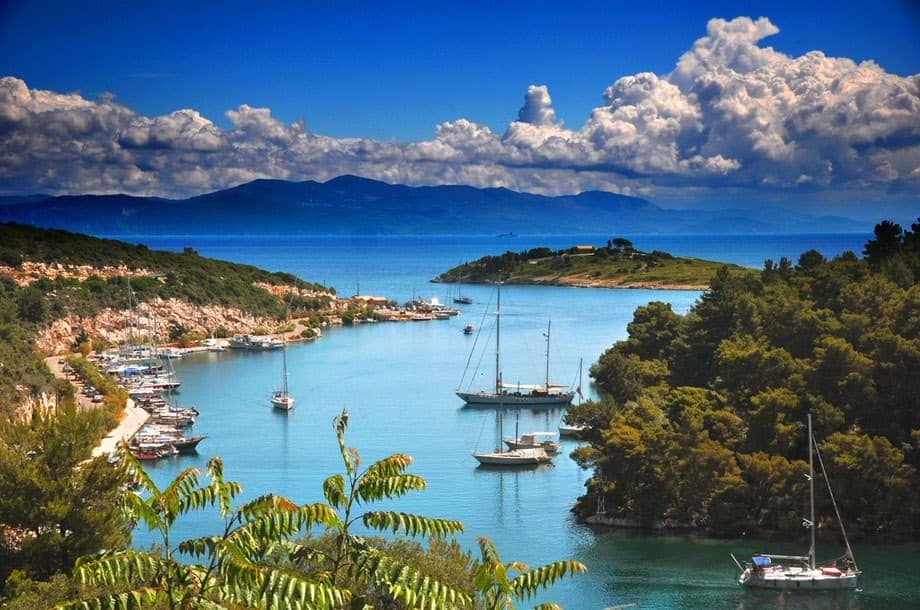
>>Also Read: Best Marinas in Greece
Corfu and Paxoi
Corfu’s beaches are among the best in Greece, with emerald carpets of trees spread across the hillsides. Sand beaches and picturesque fishing villages add to the natural splendor of the island. The sea’s and pleasant air temp, as well as the overall atmosphere, is serene and peaceful. Long thin cypresses, antique silvery-gleaming light-green olive trees, and an Italian-style capital make up the idyllic environment. Have your lunch and stroll around the Old Town of Corfu. And, then rent a car or a motorbike to explore the rest of the island. Benitses, Petriti, and Lefkimi are among the must destinations you should go to and even stay overnight. Note that both the northern and southern Ionian Islands are included in the typical Corfu sailing itinerary. Also, if you have the time, consider sailing to Diapontia Islands; Othoni, Ereikoussa, and Mathraki – a true sailors’ paradise!
Paxos is located just 7 nautical miles south of Corfu. Gaios is the main harbor on the island of Paxos and it consists of a lengthy natural inlet. The port provides excellent protection in most weather conditions, however, sometimes severe winds make the southern side uncomfortable. Anti-Paxos is a small island off the coast of Paxos. Both islands consist of lush greenery landscapes, hiking on land, as well as great anchorages. Also, without exaggerating, there’s literally no beach on the island that you would not want to swim! Furthermore, there are several traditional taverns along the seaside. You can taste fresh seafood, and if you’re feeling energetic, you may trek the historic trails that lead to tiny chapels, little settlements, and hilltops with breathtaking views of the sea.
Mongonisi, on Paxos Island’s southern tip, is a beautiful natural harbor to anchor. You also have the option of docking your boat at the inlet’s quays or anchoring off the coast. Finally, there are also two bays on the east side of Anti-Paxos island where you can find several secluded anchorages.
Ithaca
Ithaca is a rocky island separated from Kefalonia by the Ithaca channel, which is 2 nautical miles wide, and is virtually cut in half on its east side by the lengthy Gulf of Molos. Also, the isthmus connecting the two halves, at Mount Aetos, is only 600 meters wide. The island is divided into two parts, about equal in size, and united by the narrow Aetos (Eagle) isthmus. The two halves encompass Molos Bay, whose southern branch is Vathy Harbor, the island’s capital and main settlement. In the northern section of the island, Stavros is the second largest village. Vathy’s main harbour is located at the back of a deep bay and provides a safe and welcoming environment. The smaller, wooded islands of Kalamos, Kastos, and Meganisi are also worth visiting if you have the time.
On the eastern coast of Ithaca, there is a rich environment with several bays and capes. The island’s northernmost point is Cape Melissa, while its southernmost point is Cape Agios Andreas, with a total length of 101 kilometers. Kioni village has its own small bay where you may moor and enjoy local cuisine in the tavernas while admiring the beauty of its simplicity. You may also anchor off the coast of Gidaki and dive into the Ionian Sea’s azure seas.
Kefalonia
Kefalonia is the largest of the Ionian Islands, with harsh limestone hills rising to Mount Ainos and fertile valleys dotted with lush vegetation. The sophisticated harbor of Fiskardo, as well as Argostoli and Sami, are all must-see destinations. Fiskardo is on the island’s north-eastern tip, and it’s known for its still-standing 19th-century Italian architecture. Stores, boutiques, local tavernas, and nightclubs line its picturesque shoreline. Fiskardo is also a fantastic starting point for visiting the island’s northern fortifications, monasteries, museums, and hiking trails. It’s also nearby many secluded coves with crystal clear seas, which are great for swimming, diving, or just relaxing aboard.
Also, even though Lixouri and Atheras are open to the north, you will find a covered anchorage. That is, even in the face of strong NW winds, the tiny island of Atheronisi protects the anchoring from the waves. Assos, Kalo, and Platy Limani, as well as Poros, provide safe anchorages and are among Kefalonia’s most beautiful and peaceful destinations.
The Sporades Islands
The Sporades Islands are located off the northwest coast of the Aegean Sea. Within a tiny island territory, it’s a sailing destination with a lot of beauty and an amazing range of wonderful beaches. The islands, which are just north of Evia, are a group of lushly green islands with high topography, making them some of Greece’s greenest ones. There are a total of 24 islands, however, only four are inhabited; Alonnisos, Skiathos, Skopelos, and Skyros. The Sporades Islands are considered the less-visited ones and the furthest islands are only accessible by boat. You can sail around the main islands of Skiathos, Skopelos, and Alonissos, as well as the uninhabited Sporades islands further away.
Keep in mind that during the peak season, July and August, it can be particularly busy on Skiathos. It may be also difficult to secure a mooring spot in the ports as most of the islands are full of tourists. However, this is the season for you if you enjoy being in the midst of the masses at parties. You may always sail away to a more remote location when you’re on a boat, but it’s important to be aware of that, especially when provisioning. Temperatures are also fairly high at this time of year, and it may get very hot on a sailboat because you are constantly exposed to the elements.
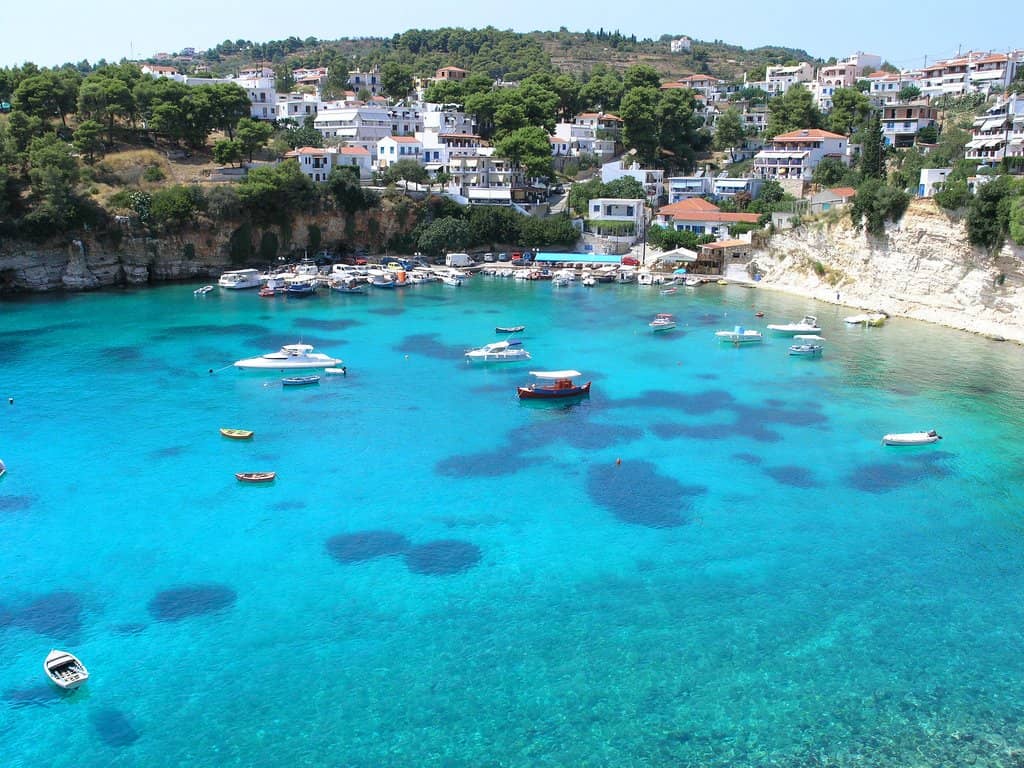
>>Also Read: Best Sailing Routes in Greece
Skiathos and Skopelos
The island of Skiathos is the most accessible from mainland Greece, as well as the busiest. It’s famed for its vibrant port town and busy nightlife, although getting a mooring spot can be difficult in high season. You have many choices here as there are 64 beaches to explore, most of which are sandy and some of which are only accessible by boat. If you wish to avoid the throngs, there are plenty of places to moor for the night. Koukounaries Beach is six kilometers southwest of Skiathos Town. Despite the fact that it is a crowded and popular beach, most day-trippers leave by sundown, making it a wonderful area to anchor for the night.
The picturesque tiny islets of Maragos, Tsougkrias, and Tsougriaki are located directly across from Skiathos Town and are well worth a visit. These are great places to spend the day or the night. Sailing on the northern side of Skiathos is more difficult, especially when the winds are strong. It’s wilder and less touristic on the northern side, which will appeal to nature enthusiasts seeking peace and quiet.
If sailing east from Skiathos then your next stop is Skopelos. This green and beautiful island boasts a number of wonderful ports where you can spend the night. Glossa, Neo Klima, Argnontas, and Panormos are all ideal sites to anchor for the night along the southern coast, with Panormos being the most natural with the fewest facilities and without a quay. You can get on land and take the bus to the popular “Mama Mia” chapel, or simply stroll around the port and have your lunch in a local tavern.
Except for the Bay of Skopelos, the sheltered southeast coast has many pebbled beaches, but the northwest coast is exposed to the wind and sea, with high cliffs and few good anchorages. Skopelos Town, the only place to stay on the northern coast, is worth seeing for its narrow alleyways and quaint shops. If the weather permits, sailing around the northern shore on your way to Alonissos is a must!
Alonnisos
Alonissos is the most isolated of the inhabited islands, surrounded by the Alonissos National Marine Park in the North Sporades. The last European colony of Mediterranean monk seals lives in the marine park, yet these secretive creatures are difficult to spot as they’re constantly on the move. Alonissos is the least congested of the Sporades, and it’s a fantastic place to start your sailing voyage and explore the outer islets. Patitiri’s main port is attractive, though congested with sailboats during the high season. The Old Village, which offers great views of the island, is accessible from here.
There are wonderful beaches along the island’s west coast that are also worth visiting, and Steni Vala is a nice spot to stop for provisions and tavernas before setting sail for the even more distant isles. Just opposite Steni Vala, you will see the island of Peristera, which has many beautiful anchorages and coves, like Vassiliko Bay, which is said to be the “safest harbor in the Sporades” and there’s also a half-sunk ship there.
Skyros
Skyros is an outlier island with a distinct atmosphere that is more akin to the Cyclades than the Sporades, as well as being less sheltered. There is, after all, some separation from the others, and a daring sail away. In any case, it’s well worth a visit if you have the time. Linaria is a little bay where you can get fuel, water, tavernas, and basic provisions. For a wider range of options, you can take the bus to Chora and stroll around the main village. Note that the W-SW coast has the majority of beaches and anchorages. Some of them are Atsitsa, Alyko, Agios Fokas, Pefki, and Acherounes.
Sailing around the islets of Skiropoula, Sarakino, and Prasso, as well as the rocky bay of Tristomou, Kalamitsa beach, Kolympiada, and Renes beach, make up the fantastic sailing experience. Lastly, in case north winds aren’t blowing, the N and NE coast of Alonnisos is totally accessible. And, you will also find magnificent anchorages and beaches there.
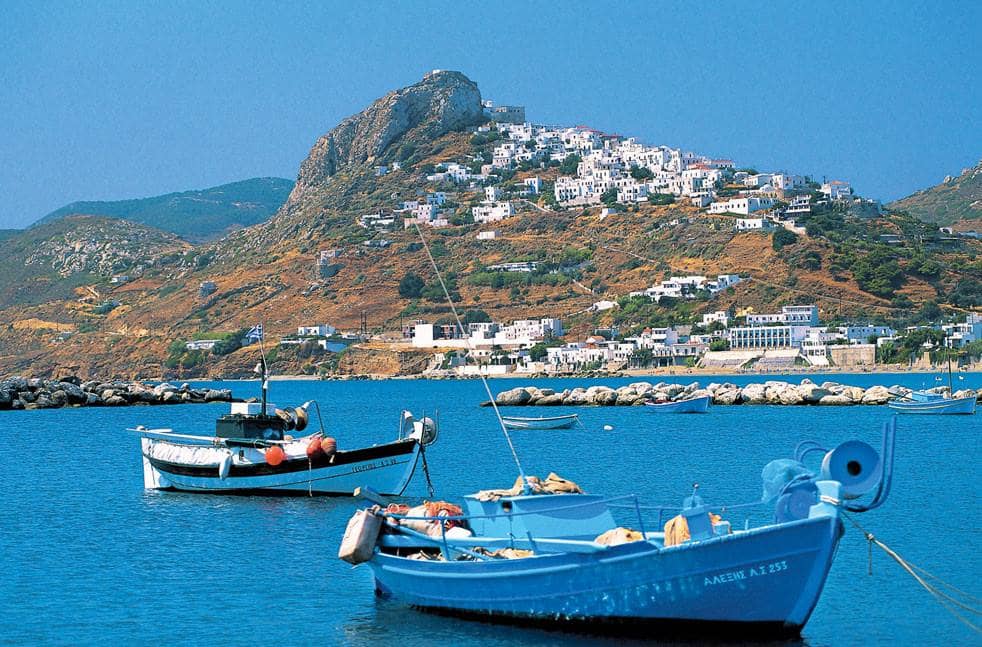
>>Also Read: Best Place to Live on a Boat in the World
Greek Island Sailing Guide – The Bottom Line
It’s a fact that Greece offers a wide range of sailing opportunities for all types of sailors and demands. Of course, you will be the one for organizing your sailing routes and explore the Greek seas according to your time, vessel, and preferences. Remember to always check the weather forecast ahead of time, and sail during the quiet months rather than the busy months. If this is not possible, you can sail in the Sporades, the North Aegean Islands, or in the Dodecanese complex, which have fewer tourists. In any event, you have a plethora of choices; so many, in fact, that it might be tough to make a decision! In any case, I hope that this article will assist you in arranging your sailing voyage in the Greek Islands.
Even though this isn’t a totally complete guide for sailing in the Greek Islands, the above-mentioned destinations are one-of-a-kind and a true sailors’ paradise. Wish you all safe & pleasant voyages!
